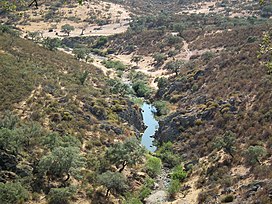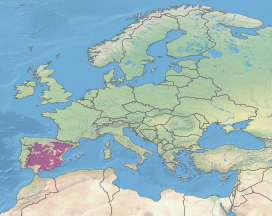Iberian sclerophyllous and semi-deciduous forests
| Iberian sclerophyllous and semi-deciduous forests | |
|---|---|
 Natural landscape around the Safareja watercourse, Moura, Portugal | |
 Location of the ecoregion (in purple) | |
| Ecology | |
| Realm | Palearctic |
| Biome | Mediterranean forests, woodlands, and scrub |
| Borders | List
|
| Geography | |
| Area | 297,804 km2 (114,983 sq mi) |
| Countries | |
| Conservation | |
| Conservation status | critical/endangered |
| Protected | 74,552 km² (25%)[1] |
The Iberian sclerophyllous and semi-deciduous forests is a Mediterranean forests, woodlands, and scrub ecoregion in southwestern Europe. It occupies the interior valleys and plateaus of the Iberian Peninsula. The ecoregion lies mostly in Spain, and includes some portions of eastern Portugal.
Geography
The ecoregion covers the interior basins of Iberia's main rivers – the
Climate
The ecoregion has a Mediterranean climate. The ecoregion's interior location means a hot, dry summer. Winters are generally mild, and colder in the northern portion of the ecoregion.[2]
Flora
Plant communities include forests, woodlands, maquis shrublands, grasslands, low shrublands, and wetlands. The predominant trees are evergreen sclerophyll broadleaf species and conifers.[2]
Forests of holm oak (Quercus rotundifolia) and cork oak (Quercus suber) were once predominant in plains and valleys with deep alluvial soil. Over centuries most of these forests have been converted to agriculture, pasture, or maquis shrubland. Maquis shrubland is a dense thicket of tall woody shrubs and low trees, mixed with low shrubs, herbs, and grasses.[2]
Olive-carob woodlands and maquis are common in the southern portion of the ecoregion, and in canyons in the northern Douro and
Forests of stone pine (
Areas of the southeast and Ebro valley with limestone, marl, and gypsum-derived soils are home a mosaic landscape, with mixed forest of
Extensive seasonally-flooded saline wetlands of
Agroforestry landscapes
Traditional agrosilvopastoral landscapes, known as dehesa in Spain and montado in Portugal, are found in the western portion of the ecoregion, and extending into the adjacent Southwest Iberian Mediterranean sclerophyllous and mixed forests ecoregion. They include scattered cork oak (Quercus suber) and holm oak trees interspersed with agricultural fields, olives and other fruit trees, and pastures. Dehesas support wildlife as well as livestock and crops, and forest products like cork, honey, mushrooms, and wild game. Over the past century many dehesas and montados were cleared to create larger single-crop fields of grain and other agricultural commodities.[2]
Fauna
The ecoregion is home to small populations of Iberian wolf (Canis lupus signatus) in the plains of northern Castile, and Iberian lynx (Lynx pardinus) in the southwest. Year-round resident birds include the Spanish imperial eagle (Aquila adalberti) and great bustard (Otis tarda). The woodlands are a wintering area for common cranes (Grus grus), and a breeding area for white storks (Ciconia ciconia) and black storks (Ciconia nigra).[2]
Protected areas
74,552 km2, or 25%, of the ecoregion is in
References
- ^ a b Eric Dinerstein, David Olson, et al. (2017). An Ecoregion-Based Approach to Protecting Half the Terrestrial Realm, BioScience, Volume 67, Issue 6, June 2017, Pages 534–545; Supplemental material 2 table S1b. [1]
- ^ a b c d e f g h i j "Iberian sclerophyllous and semi-deciduous forests". Terrestrial Ecoregions. World Wildlife Fund.
External links
- "Iberian sclerophyllous and semi-deciduous forests". Terrestrial Ecoregions. World Wildlife Fund.
